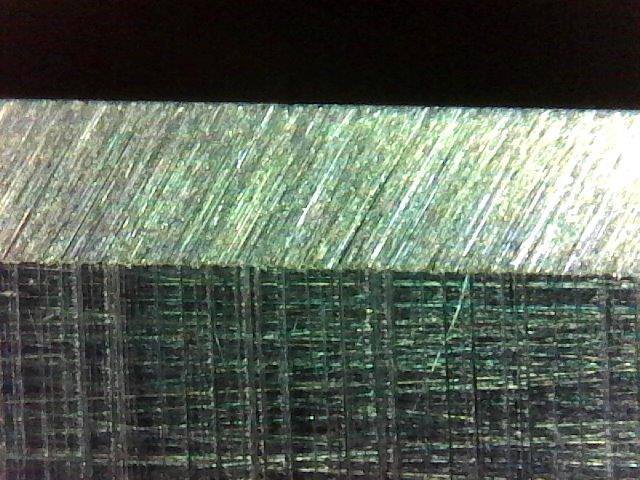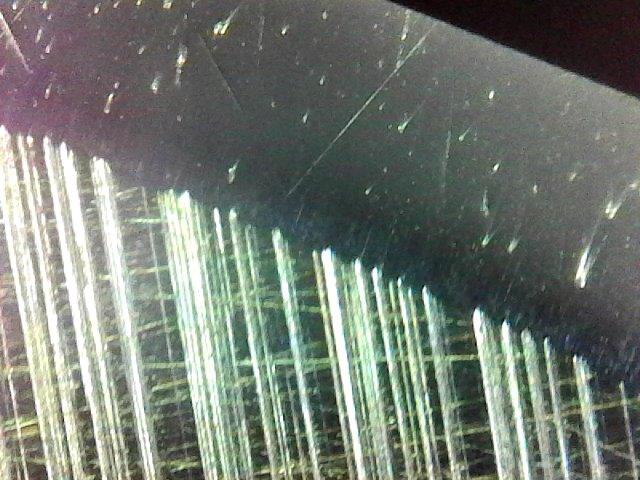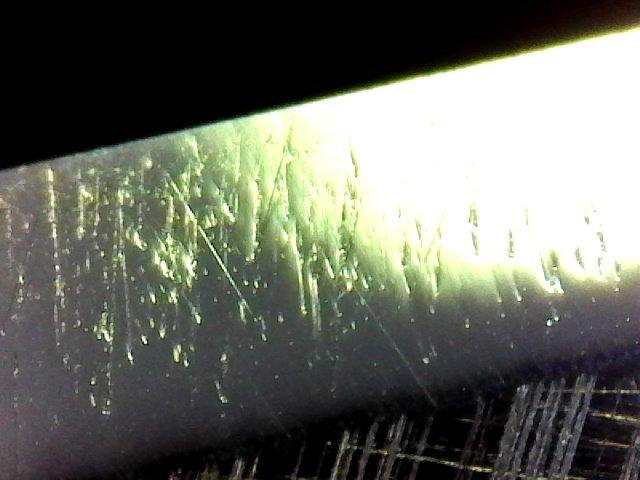Stropping, Angles and Dumb Luck
Recent › Forums › Main Forum › Stropping › Stropping, Angles and Dumb Luck
- This topic has 14 replies, 8 voices, and was last updated 11/28/2020 at 4:57 am by
 tcmeyer.
tcmeyer.
-
AuthorPosts
-
07/31/2020 at 10:30 pm #54716
My strategy with recent knives is to run diamond stones up to 3000, then micro ceramics, balsa wood strops, 3 micron lapping films, then leather strops at 14, 10, 4, 2, 1, and 0.5 micron. When I move to leather, I back off the sharpening angle by 2 degrees. The result is a very shiny edge. However, the edge is not as sharp as I would like. Once I remove the knife from the clamp and free hand strop on 0.5 and 0.1 micron strops, the sharpness improves massively. I am not bragging. Actually, I have no idea what’s happening. How can it be that a YouTube watching asshat like me gets better results freehand stropping than in the jig? Is 2 degrees too far? Should I only back off 1 degree? 0.5?
Grateful for the input.08/01/2020 at 1:22 am #54717ModernFlame said: “I have no idea what’s happening”
Some times I learn from other People, and some times I learn from the knives I sharpen.
I am not saying I have your right answer, but I am happy with 400 grit as my final Diamond stone and going to Kangaroo Leather strop, with just some leather conditioner to keep it from drying out, usually getting a little below 200 on the “Bess” sharpness tester.
My target for sharpness is just below 200.
When I use the leather strop on the “Wicked Edge” I back off 3 and 1/2 or 4 degrees.
I get the impression that I may be the only one on this forum that backs off the leather strop that far, but it has never failed me.
My diamond stones are well broke in.
08/01/2020 at 7:26 am #54718Very interesting. I’ve been programmed to use leather strops with minimal pressure, so my first thought was that I had backed off too far and thus was not cleaning the apex. But maybe I’m actually rounding off the apex because I haven’t backed off far enough. Maybe I’m just stropping too much? I know I don’t need all of that polish, but I like the bling on some of my finer knives.
08/01/2020 at 8:20 am #54719That happens..If you have a USB microscope you can see the top of the bevel will reflect light when a bright light is shined on it if it is rolled, with soft metal it does not take much.. depending on how bad you rolled it you may be able to see the shiny spots (looking down on the bevel with bright light shining over the bevel from in front of you) just looking at it. The very apex of the knife should never shine, if it does that is a dull spot.
Also Stropping, if not rolled, will stretch and smooth the steel as well as burnish it (read that on the forum) which will remove any tooth that may still be there, which does make it sharp but may not cut what you want well, depending on what it is..
Personalty I am no expert and I don’t sharpen any fancy knives, just keep the knives the wife uses sharp, she likes me to stop at 1000 diamond as that cuts the food the best for her.. I used to do 1500, 6 micron film then strop. Stropping is an art I did not learn well yet, so rather than dull the knife I just sharpened, I just stop right there and she is happy 🙂 All of the guys here who really know how to strop, will strop after whatever grit they stop at and they get good results, practice, observation with a microscope, and attention to detail will most likely be the way to learn stropping the fastest if you so desire. It is just not something I have done myself due to lack of need.. “happy wife, happy life!
Good luck and keep at it, WE makes it many times easier than free hand but it still takes practice and technique
08/01/2020 at 11:52 am #54720I believe that if the leather is touching the apex while stropping.
The leather will have an “affect” on the edge.
The sideways “pressure” of leather can damage the edge.
I do not have good control of my hand pressure so I back off the angle, which will take longer to have the same sharpening affect.
08/01/2020 at 1:24 pm #54721I’m not an expert either but I rarely use a strop. For most knives I like to have a 800 or 1000 grit toothy edge. Then I give the blade a couple of alternating edge leading strokes to make sure there is no burr left. Done.
08/02/2020 at 10:32 am #54722My strategy with recent knives is to run diamond stones up to 3000, then micro ceramics, balsa wood strops, 3 micron lapping films, then leather strops at 14, 10, 4, 2, 1, and 0.5 micron. When I move to leather, I back off the sharpening angle by 2 degrees. The result is a very shiny edge. However, the edge is not as sharp as I would like. Once I remove the knife from the clamp and free hand strop on 0.5 and 0.1 micron strops, the sharpness improves massively. I am not bragging. Actually, I have no idea what’s happening. How can it be that a YouTube watching asshat like me gets better results freehand stropping than in the jig? Is 2 degrees too far? Should I only back off 1 degree? 0.5? Grateful for the input.
Modernflame, you’re still relatively new in your W.E. sharpening user experience. To you I say K.I.S.
You are attempting to employ a lot of different mediums in an order of use that seems logical to you. Possibly you are following someone else’s suggestion or guidance.
The issue I want of suggest is that each different medium you choose to use requires it’s own learned user experiences and nuisances. This takes time and practice you are first gaining. Each medium contributes something different to the bevel and your apex. It takes some amount of learned experience to know when you’ve achieved the best benefits of each and every different grit and medium. When you need to still do more, or when you’re ready to quit and move on. It may be not enough effort yet or it’s being overdone. This is where user experience plays a role.
To guess in your long intertwined progression where the results your unhappy with came from can be difficult with all those different mediums. To assume it’s the results of the last step may not necessarily be the case.
I summit to you, you are sharpening and polishing a knife. Just like making a mole sauce or a curry, there are a lot of steps and ingredients. Everything done in the right order, the right way for the right amount of time contributes to the final outcome.
It may be better right now to keep it simpler. Maybe look to fewer ingredients, fewer mediums in your progression for the final taste, the final sharpness and polish, you’ll be happy with. Do it this way with good consistent results, for now. Later you can add to and build on your progressions. Master less before you look to use more.
This will allow you to discern where it doesn’t work, for you, and what’s contributing to the breakdown in your results. Time and experience will allow you to know when you need more and when enough is enough.
Stropping is a whole separate set of skills all unto itself. It requires a balance of stroke direction and pressure. It can add alot to the results or totally ruin them too. Check this out: https://www.youtube.com/watch?v=XJJ-2pFpDqk&t=7s
Marc
(MarcH's Rack-Its)2 users thanked author for this post.
08/02/2020 at 10:51 am #54723Thanks, Marc. I’ll check out that video. Pretty sure it’s the last step, though. Otherwise a few passes on a submicron strop wouldn’t clear it up. Last night I sharpened a cheap santuko with the above listed media, but I skipped the WE strops and went straight to the freehand paddle strops. True, I don’t own the edge on up, but I achieved my sharpness goal. Gotta be something about the strops, the angles, and the pressure. I’m going to do more experimenting.
08/02/2020 at 11:35 am #54724For me, stropping helps my sharpened knife edges simply slide more easily through the substrate I’m cutting or slicing by finely polishing the apex and the bevels. My knife edge is very strong and sharp to start. Stropping enhances the bevel’s edges lessening the friction as the very fine remnant scratches are filled and smoothed over by the burnishing effect seen with stropping. Stropping also smooths the shoulder where the sharpened bevels interface with the knives primary grinds.
If your apex is so floppy and friable that stropping can “make it, or ruin it”. I suggest you look at the underlying support. Long, multi-step progressions, in particular those employing edge trailing stroke mediums, can lead to a thinned and elongated knife edge. Making what’s called a wired edge. It can be incredibly sharp. It just doesn’t stand up to use.
Before I ever strop, all remnants of a burr have been removed in previous steps in my progression.
Here are photos to show the burnishing or smoothing over effect seen with stropping:
The key is to learn the balance between, stropping angle and applied pressure. This is an individualized process; a trial and error procedure. It’s often recommended to start at a 2º more acute angle then go from there.
Marc
(MarcH's Rack-Its)Attachments:
You must be logged in to access attached files.
08/02/2020 at 12:38 pm #54725I’ll try one last time….
Thanks for the warning. I’m fully aware that I can stop at 400 grit, then strop on the inside of my leather belt. I could also sharpen freehand and make lots of Uncle Randy comments on the internet about sharpening on river rocks, but then I would not be a WE customer. I’ve chosen to use all of the media for two reasons. First, they need to be evenly broken in. They would serve no purpose if they were neglected, then later used only to discover that they leave rougher scratches than the rougher grits that preceded them. Second, I want to learn how to create a sharp edge with a mirror finish as a service that I can sell.
And by the way, my edge is not “floppy.” It was a burr. The point of this thread was that my stropping technique on the WE did not completely remove the root of the burr, but my freehand technique did. I’d like to improve my WE stropping technique and would welcome advice on this topic.
08/02/2020 at 1:32 pm #54730The point of this thread was that my stropping technique on the WE did not completely remove the root of the burr, but my freehand technique did. I’d like to improve my WE stropping technique and would welcome advice on this topic.
Root of the Burr?? What does that mean, there should be NO burr or hint of burr when you get to stropping.. Please define your use of the word Burr in this context.
08/02/2020 at 1:42 pm #54731I am grateful to everyone for your feedback. Thank you.
2 users thanked author for this post.
08/05/2020 at 7:15 pm #54762I am a proponent of not backing off the angle at all when I strop. My goal is to strop the whole bevel shoulder to apex and if I back off then I am relying on the correct pressure to fully engage the bevel and to me that’s nearly impossible. So I use the same angles and concentrate on the gentlest pressure needed to fully engage the bevel. I spritz the strop with iso propyl to get a very slight slurry going and then think about caressing while doing 5 alternate strokes per side. Sometime soon I will repeat this and take some 200x pics to see if I get the same amount of burnishing as the photos in this post show.
What I am actually more interested in is addressing the shoulder by backing off maybe 5+ deg and then go thru some quick progressions with some maybe heavier stropping to sort of force a simple convex-like shoulder.
1 user thanked author for this post.
11/26/2020 at 3:46 pm #55279My wife asked me to sharpen the turkey carver and it went so quick I went back to the house and grabbed and sharpened five others.
I have a wood shop with a lot of toys. Among them is an AirHandler floor model buffer (dust collection, eye shields, lighting, two speed Red Wing motor) complements of craigslist for one hundred bucks. On a whim, I cranked the buffer up to high and ran a blade on the red rouge wheel. Before doing so, the knives would push cut paper. After a couple runs per side, the knives not only pushed through paper, the friction feed back change was quite notable.
Accordingly, if anyone has a permanent station for sharpening and can set up a buff system, they’ll like the results.
2 users thanked author for this post.
11/28/2020 at 4:57 am #55288I have a Jet double-ended buffer and I’ve learned that if I want to step up my routine sharpening, I’ll stone to 2200 or 3000, then hit the buffer with a 10″ cotton wheel and white polishing compound. Pink scratchless compound also works great. One or two passes is all it takes. Maybe 5 seconds per side.
For the last 6 – 12 months, I’ve only used my DLF or strops on my woodworking chisels and plane irons.
-
AuthorPosts
- You must be logged in to reply to this topic.


